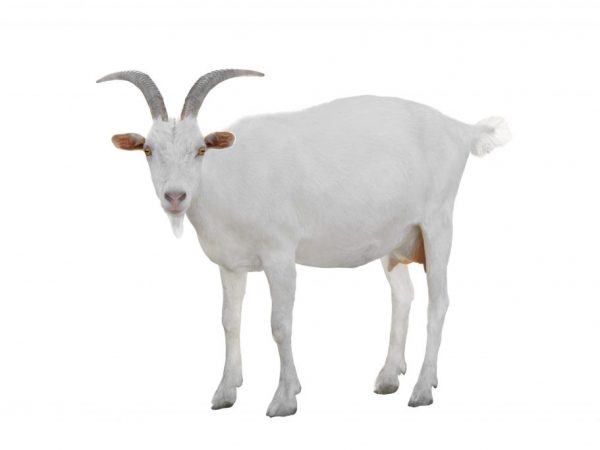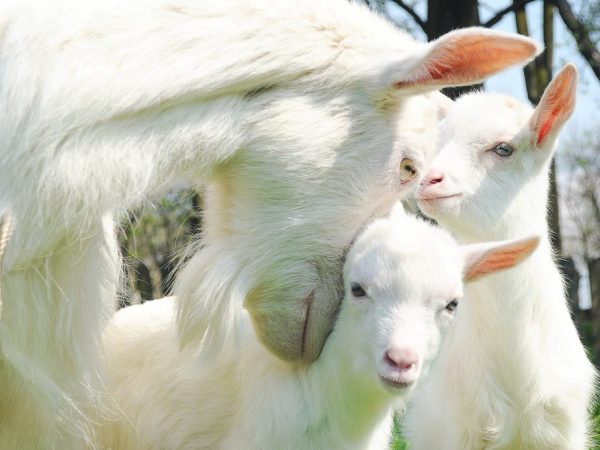Reasons for the lack of milk in a goat after lambing
Small ruminants, including goats, are bred for milk and meat. Lambing in goats usually goes away without any special problems and complications, if the breeder correctly led the animal to this stage. But it so happens that the goat does not have milk after lambing.

Lack of milk in a goat after lambing
The lack of milk in a goat after lambing becomes a real problem, since a person will have to feed the offspring on his own. You can avoid this trouble if you know its reasons.
Goat pregnancy
The female bears the kids for 150 days or 21.5 weeks. In the normal course of pregnancy, lambing occurs with an accuracy of one day. Occasionally, an animal can become overweight. If this happens, then you can not do without consulting a veterinarian.
The mating is carried out from September to March. At this time, the chance of conception is higher. In summer, because of the heat, goats may not be hunting at all. For mating, a female is chosen that has reached the age of 12-17 months and weighing at least 35-40 kilograms. Puberty in these animals begins much earlier, but it is not advisable to bring the female into the first hunt. In the future, this will affect milk yield, as well as the health of the goat itself.
For inexperienced livestock breeders, finding out whether fertilization has taken place and whether pregnancy has come is quite difficult. But there are a number of factors due to which you can understand this:
- resumption of good milk yield after hunting;
- hunting does not appear for at least three weeks after mating;
- the appearance of asymmetry of the abdomen (the longer the period, the more noticeable it is);
- an increase in the outer labia, the folds around them are smoothed;
- expansion of the pelvis.
By the middle of the term, it is already possible to detect an enlarged uterus and fetus with the help of palpation. Also, a distinctive feature of goats during pregnancy is their calmness and inactivity. Appetite only increases.
At the first lambing, the female can bear 1-2 kids. In subsequent pregnancies, the number of fetuses can vary from 2 to 4. Very rarely, a goat is able to bear five babies. This is not very good for the health of the mother and her offspring. Multiple pregnancies are also dangerous because weaker kids can be injured in the womb, strong ones.
Goat lamb

Goat mother is very caring
The date of the onset of lambing is calculated based on the date of fertilization of the female. You can also be guided by external factors indicating an imminent birth:
- swelling of the udder;
- symmetrical pits on the wallpaper side of the base of the tail - divergence of the pelvic bones;
- anxiety;
- the animal constantly lies down and gets up.
With the appearance of these signs, it is necessary to take the animal under observation. If the goat has already had a successful experience in childbirth, then you can leave it alone and not interfere with the lambing. If the goat is a first-calf, then it may need the help of the owner. So that this does not come as a surprise, it is better to show it to the veterinarian in advance.
First, a transparent mucous plug leaves, then the fetal bladder is shown.The animal bites it on its own or the person taking delivery does it with a clean, disinfected needle. Next, the legs and nose of the goat should appear. Sometimes, an incorrectly presenting fetus can cause difficulties in childbirth. If the goat kid squeezes the front legs under the belly, then the veterinarian or the breeder himself, between contractions, tries to straighten these legs.
When the baby goat is born, the mother gnaws through the umbilical cord and licks the baby. Labor can last from 30 minutes to 2-3 hours, depending on the number of fetuses. After the birth of the last kid, the afterbirth comes out. At this point, the lambing can be considered complete.
If the kids are planned to be fed separately from the mother, then they are taken and taken to a place where the female does not see or hear them. After 3-4 days, the so-called "oxytacin window", which is responsible for the maternal instinct, ends. Often a goat takes a milkmaid for her cub.
Newborn kids are cleansed of mucus and films from the nose, wipe them dry and give warm milk from the nipple to drink. If the cubs are planned to be left with their mother for the period of feeding, then the kids independently find the mother's nipple. Weak cubs need help with this.
Reasons for the lack of milk in a goat after lambing
Sometimes it happens that the milk yield of a goat after lambing is too low or even absent. This problem is often faced by inexperienced breeders. This happens for several reasons:
- improper milk production after lambing;
- udder problems - mastitis;
- lack of launching a goat before childbirth;
- lack of juicy feed in the animal's diet;
- low-calorie food;
- complications during lambing.
All of these problems can be avoided by taking proper care of the goat. If the birth of the goat was successful and there are no external deviations from the norm, then you can try to milk the female.
Sometimes the goat's milk becomes bitter and absolutely impossible to drink. Kids also refuse bitter milk. In this case, make sure the goat does not eat maple branches, wormwood, or other bitter herbs. They can affect the taste of milk.
How to milk a goat after giving birth

The kids should have enough milk
The goat begins to distribute after the birth of the last goat. This stimulates the contraction of the uterus and promotes the safe exit of the placenta.
Correct and timely milk production can significantly increase milk yield. It is necessary to take into account the following points:
- Before the first milking (this also applies to all subsequent milking), the udders are washed with warm water and wiped dry with a soft cloth. To avoid cracking, nipples are lubricated with specialized ointments and creams that can be purchased at veterinary pharmacies. You can also prepare nipple lubricant at home from pork fat, sunflower oil and extracts from chamomile and yarrow.
- Milking should be quick. Delaying the process will entail a decrease in milk yield in the future. The grip of the nipples during milking should depend on their shape and length. Long nipples are milked with a fist, and short ones with two fingers. The first time after lambing, colostrum is excreted. It is salty, has a thick consistency and a specific smell. Allocation of it lasts up to three days.
Hand feeding the goat is preferable to leaving the kids underneath. If the kids are more than two, then they will constantly suck the udder, not allowing the mother to eat and sleep in peace.
Experienced breeders advise to feed the kids separately from the mother. Grown kids, especially males, push the goat under the udder with such force that they can damage the alveoli of the udder. In this case, blood begins to enter the milk. Mastitis may develop.
Starting a goat correctly before giving birth
How much milk a goat will give depends on the capabilities of its body. If the animal is exhausted, does not receive enough nutrients or has a number of diseases, then there is no need to wait for a good milk yield.
It is recommended that the pregnant female be given a short-term rest from the previous lactation. This is done so that the nurse's body recovers and is ready for childbirth and subsequent lactation. This process is called starting the goat. Well-fed goats are launched two weeks later.
If you follow all the rules for starting, then in the future the goat should give a lot of milk. This amount is usually sufficient for feeding the offspring and the household needs of the breeder.
So how do you properly start a goat? One and a half to two months before the expected date of birth, it is necessary to completely stop milking the goat. This is done gradually. The time between milkings increases to 8 hours. As soon as the volume of milk decreases, they switch to milking every 12 hours. When the milk yield is reduced to 1.5 liters, ragged milking can begin. This means that the time between milkings is increased by 1 hour every day, until its frequency decreases to 1 time per day. After that, the goat is milked only once every 2 days.
Over time, the milk completely disappears. Sometimes the animal stops lactating by itself. This happens during multiple pregnancies, when the goat cannot provide enough nutrients to the kids that develop in its womb.
If the launch is not done, then the goat will give little milk after lambing, and the cubs will be born weak and small.
It is also worth remembering that the animal needs a special diet during launch:
- at the beginning of the launch, the proportion of vegetables, herbs and concentrates in the goat's menu is reduced, since juicy feed provokes lactation;
- when there is very little milk and whether it has completely disappeared, the diet is restored, increasing the proportion of concentrates;
- while the milk yield is reduced, they give warm water with wheat bran;
- root vegetables are given only boiled.
It should not be forgotten that preparing the animal for covering, full care during the period of gestation and proper nutrition is the key to the health of both the mother of the goat and the offspring. If the goat is properly raised, there will be no problems with the launch.
Most often, the reason that the cattle refuses to mate, or worse, self-aborts, is the improper development of the animal. If the goat is weakened before and after mating, it may even die during lambing.
Conclusion
In order for the goat not to lose milk after lambing, it is necessary to provide it with a full-fledged high-calorie diet, a clean barn and affection. As strange as it may sound, light stroking and massage of the udder during milking is beneficial to the goat, increasing milk yield.
Before giving birth, the female will not be disturbed by silence and calmness, since stress can also reduce the amount of milk in the future. If you distribute and run a goat according to all the rules, then in the presence of milk she can not worry.


